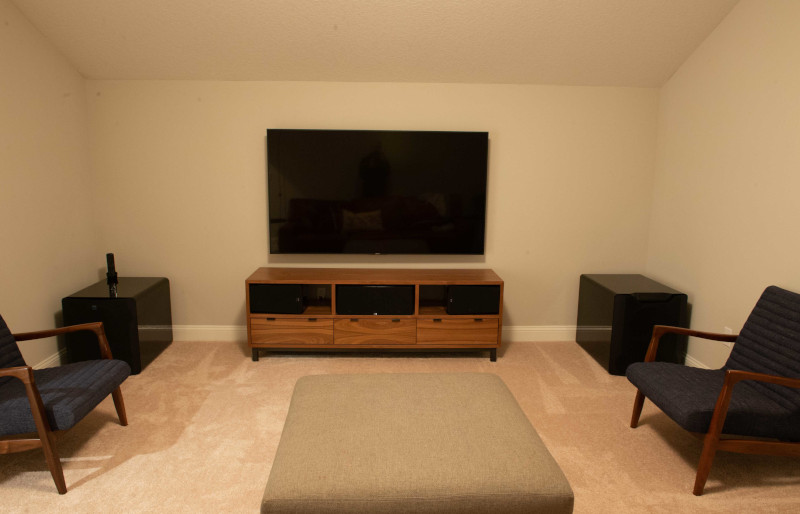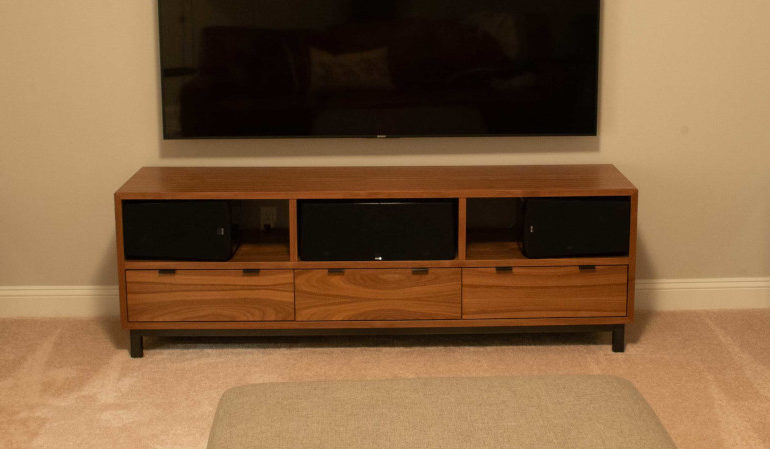Best Home Theater Speakers to Place Inside Cabinets
Very often people want to hide their speakers in their home theaters. They would love to do an all in-wall or in-ceiling setup, but those types of speakers are hard to install for many. Their next idea is to place their home theater speakers inside an existing cabinet. They have the furniture (they’ve had it for years). If they just put the speakers inside, they’ll be less noticeable. It isn’t the cleanest look, but it is better than having them out in the middle of the room.
And then they do some research online. Every single piece of advice practically screams, “Don’t do it!” Speakers aren’t meant to be put in cabinets. You’ll ruin the sound! It’ll be terrible!
We’re here to tell you that…well…is mostly true. But you are going to do it anyway, aren’t you? So, here’s how you do it so it will be the least bad. And, just to warn you, some of our suggestions are just as difficult as having in-walls installed.
How To Use Freestanding Speakers
If your plan is to buy regular home theater bookshelf speakers and place them inside a cabinet, there are a couple of things you want to pay attention to when shopping. First, you want the speakers to either be sealed or front ported. Many (some might claim most) speakers have a port in the back. This is not great for in-cabinet installations. So, either you want a speaker with no port or with a port that is facing forward.
Second, you want to pull your speaker as far forward as possible. At the very least, you want the front of the speaker (not the front of the grille) to be in line with the front of the cabinet. If possible, have it a little overhanging. This will give you the least bad sound from your freestanding speakers

Lastly, fill as much of the space around the speaker with sound-absorbing material. If you are planning on somehow covering the front of the cabinet opening (with acoustically transparent fabric for example), fill ALL the space with insulation (any will do). If you aren’t, you may have to be a bit more creative. But the key is we don’t want the sound from the speaker to reverberate around the cabinet it is in. Filling the space with sound-absorbing material will help.
For Better Sound, Use In-Wall Speakers
If you are someone that can’t install speakers in your walls for reasons (whatever they may be), you can use those same speakers but installed in your cabinet. Now, this is going to take some doing to do right. But it can be done. And, honestly, it will probably sound better than using a freestanding speaker. But how?

First, take a look at your cabinet dimensions and the speakers you are thinking of buying. Each in-wall speaker has some sort of indication of what volume of air should be behind it. If possible, match that volume of air to the internal volume of the cabinet. A handy person can make this happen. If you are not, you may have to compromise. But try to match the volumes as closely as possible.
Now, you are going to need to seal up the cabinet space. The first thing you’ll want to do is make sure there is a sturdy back on your cabinet. Many cabinets might have decent enough walls/shelves, but the backs are just thin wood that is barely thicker than veneer. This won’t do. You’ll need to reinforce it (better to replace it) with something sturdier. Plywood at the very least. Or MDF. Consider adding bracing to reinforce the walls/back as well.
Now it is time to caulk. You need the cabinet to be essentially waterproof (we are really trying to keep in the air but you get the idea). Caulk all the corners and gaps. You’ll need a hole to run speaker wire into the cabinet so make sure you caulk those gaps as well. Make sure you use acoustic caulk.
Fill any remaining internal volume with acoustic material. Insulation would be best though acoustic foam works as well. Just make sure you leave room for the back of the speaker and extra wire.
Lastly, you’ll want to install a front. That front will hold the in-wall speaker. You can install the front and then add the speaker or install the speaker to the front plate before securing it to the cabinet. We think the former will be easier, but it is up to you. Don’t forget to add more caulk around that front plate!
Wrap Up
Placing home theater speakers inside a cabinet isn’t impossible, it is just a lot more complicated than placing speakers in your room. If you read back over our in-wall suggestion and said to yourself, “Hey! They are just telling me to build a speaker cabinet into my furniture!” You’re right. That’s exactly what we are suggesting. In-wall speakers assume that there are flat surfaces to all sides of the front of the speaker. Freestanding speakers are built with the assumption that there will be air outside the cabinet. This is why in-wall speakers make the most sense if you are going to place them in a home theater cabinet. An easy solution? No. But it is the best one. And that is what we’ve promised.


